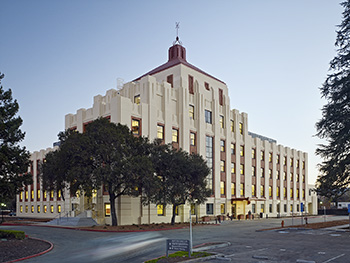Hoover Pavilion Marks First Step in Stanford Project
 STANFORD, Calif. — The renovation of Hoover Pavilion, one of the first completed stages of the Stanford University Medical Center Renewal Project, opened last December, as the facility’s new nine-level parking garage is set to debut in September.
STANFORD, Calif. — The renovation of Hoover Pavilion, one of the first completed stages of the Stanford University Medical Center Renewal Project, opened last December, as the facility’s new nine-level parking garage is set to debut in September.
Known as the original Palo Alto Hospital, Hoover Pavilion was renovated to accommodate modern medicine, while preserving the exterior of the 83-year-old landmark Art Deco building. San Francisco-based Page & Turnbull served as the preservation architect.
The 82,000-square-foot landmark building was constructed in 1930 with a second wing added in 1939. In order to recreate the historic space, the design team had to study the history of the building through old photographs, diagrams and reports. The research helped determine the design, which was approved unanimously by the City of Palo Alto and the Architectural Review Board.
Page & Turnbull restored and reused the 1931 façade and building, which was originally designed in the style of a ziggurat: a terraced pyramid built by Babylonians during ancient Mesopotamia. The project also included significant upgrades to the interior spaces to allow for wider hallways and more open spaces. That rehabilitation work included analyzing terra cotta tile wall panels, board from concrete, wood windows, historic light fixtures and the replacement of the pyramidal roof. All of the work on the project conformed to the Secretary of Interior’s Standards for the Treatment of Historic Properties.
Page & Turnbull conducted a paint analysis to determine the building’s original colors, and the company also used photographs to replicate a decorative metal finial that was removed in the 1940s. During the project, there were issues with contaminated concrete aggregate used in 1939, but Page & Turnbull was able to come up with a cost-effective and design-friendly solution for the concrete.
The building houses community physicians and Stanford Hospital clinics, as well as the Stanford Health Library, a pharmacy and a cafe. It is integrated into the surrounding campus through extensive landscaping and gardens, including a lawn and Redwood Grove, which allows for easier patient and employee access. The new parking garage will also add more than 1,000 parking spaces for employees, patients and staff, making it easier to park at the facility. Plus, the parking structure is constructed of precast elements that include a hybrid moment frame system for increased seismic performance.
The Hoover Pavilion project is part of the $5 billion Stanford University Medical Center Renewal Project, which includes the $2 billion Stanford Hospital, as well as the Lucile Packard Children’s Hospital expansion project, the Welch Road Utility Project and the replacement of School of Medicine facilities.
“Stanford Hospital & Clinics seeks to transform patient care, with a focus on delivering our unique brand of leading edge and coordinated care,” said Amir Dan Rubin, president and CEO, Stanford Hospital & Clinics in a statement. “Advancing the way in which care is delivered requires state-of-the-art facilities that are designed to provide patients with a healing environment and can accommodate new technologies as they become available. We believe the new Stanford Hospital will be the world’s most advanced inpatient setting.”
The construction team broke ground on the 824,000-square-foot Stanford Hospital in May. Scheduled for completion in 2017, the hospital is expected to open for patient care in early 2018 but remains operational.
